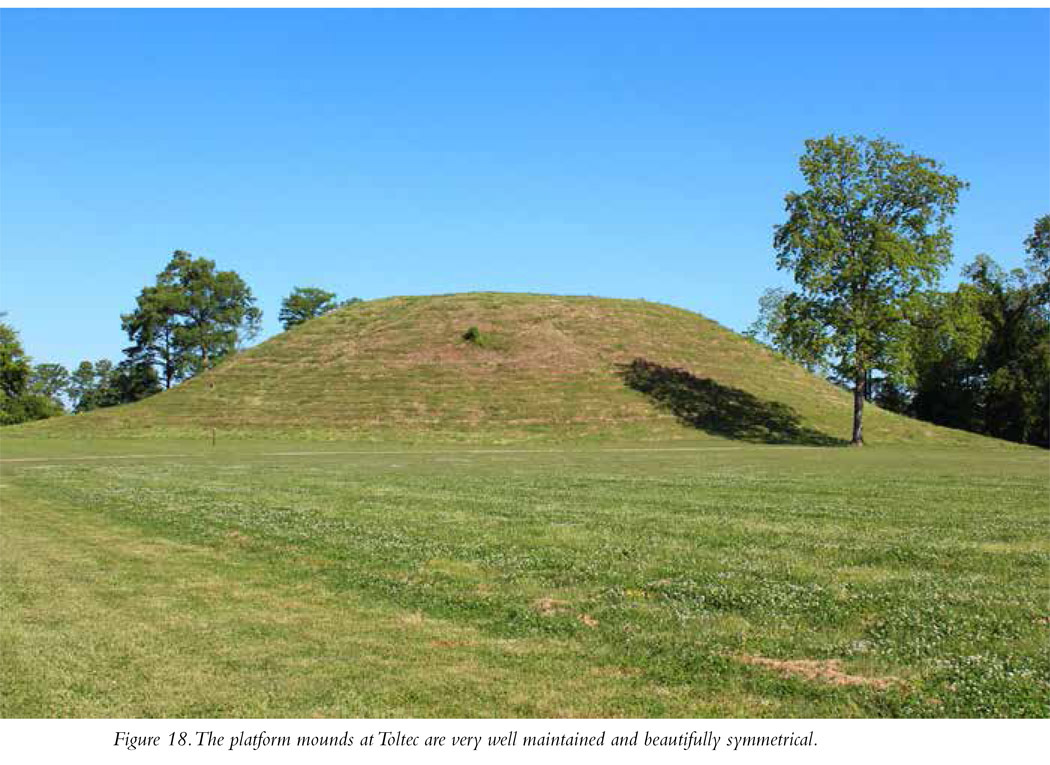
Scott, Arkansas
Journal Entry
April 18, 2012
Sometimes when walking around an ancient archaeological site during my odyssey, I thought to myself, I would have liked living here. Toltec Mounds was like that. It’s quite simply a beautiful, peaceful place. The three primary and well-preserved mounds are impressive, quite lovely examples of what amounts to an ancient reengineering of the landscape. Also beautiful is the location of the site, adjacent to a water-filled meander scar, one of more than a dozen similar curved channels of water in the area that now are individual lakes but were in the past segments of the Arkansas River. Check out the region surrounding Toltec Mounds on Google Earth and you’ll see them. Now looking like curved squiggles on the landscape, they are deserving of their common name, “oxbows,” for their similarity in form to the U-shaped part of an ox’s harness. Meander scars, or oxbows, are the footprints of active rivers, channels abandoned when powerful surges of flowing water literally reconfigured the flow of the river. As I walked around Toltec Mounds I thought about the people who had lived there. Certainly they had to deal with the ever-shifting channel of the Arkansas River. The soil must have been so rich for agriculture and their harvests so rewarding that the challenges they faced were worth the price they paid.
What You Will See Mound Builders
Toltec Mounds is a ceremonial center of the Mississippian culture dating from AD 600 to AD 1050. There originally were eighteen platform mounds at the site, located within a 100-acre enclosure demarcated by a rectangular ditch and ridge of earth nearly 10 feet tall on three sides and the banks of the oxbow lake on the fourth. Three of the mounds are pretty well preserved, and two of those are impressive (I.1). Mound A is nearly 50 feet high; Mound B is only a little smaller, about 40 feet. Both of those are platform mounds (Figure 18). The third preserved mound, Mound R, is a bit smaller. There are two established trails at the site. The Knapp Trail is paved, wheelchair-accessible, and about 0.8 mile round-trip. Follow it to see the three best preserved of the earthworks. The unpaved Plum Bayou Trail is 1.6 miles round-trip and provides a broader view of the site. The on-site museum is quite good, and a thoughtful and well-crafted short film provides some context for the site.
Why Is Toltec Mounds Important?
Toltec is a great site because it exhibits very clearly the characteristics of a Mississippian ceremonial center. When we in the West think of a great, ancient civilization, like that of the Sumerians in Mesopotamia (modern-day southern Iraq), the Egyptians, or the Aztecs or Maya, we think that dense populations of great urban settlements—simply, cities—are always part of the equation. The kind of place anthropologists generally label “ceremonial centers” is alien to many of our common assumptions about a civilization. And granted, Site 9, Cahokia in Illinois for sure and to a lesser extend Site 2, Moundville in Georgia were urban, with a dense concentration of people living in tightly packed neighborhoods. But most of the impressive mound builder sites were not great population centers. There is evidence of monumental construction in the form of impressive pyramids of earth. There is evidence of social stratification in the sumptuous burials of members of the elite classes. There also is evidence of finely crafted works of art, implying that at least some members of the community spent most, if not all, of their time producing these things for the rich folks to use in both life and in death. And there’s plenty of evidence of vast and sophisticated trading networks for obtaining highly prized raw materials from their sources, often hundreds of miles distant. But many of the sites where we see this concentration of monuments, rich folks, and finely made objects, often crafted from exotic materials, do not exhibit evidence of very large populations. Instead these places of religious, social, political, and economic focus had small populations. These centers relied on a widely dispersed population of primarily farmers, who willingly provided their surplus food, their surplus labor (in building great monuments of soil for the elite classes), and perhaps even the lives of their children as warriors to the few but powerful inhabitants and keepers of the ceremonial centers.

The construction of the mounds and enclosing embankment at Toltec certainly took a tremendous amount of work, but there’s very little archaeological evidence of people living at the site. Population estimates suggest that perhaps only about fifty people lived across this enormous and impressive site. The inhabitants almost certainly were the rulers and religious elite of a people, the majority of whom lived in farming villages spread across the region.
Site Type: Platform Mound
Wow Factor: **** Some of the individual mounds at Toltec are impressively large.
Museum: **** The museum is terrific. There are lots of beautiful artifacts on display that were found at the site.
Ease of Road Access: *****
Ease of Hike: **** The area where the mounds are located is pretty spread out, so you can walk a lot. Some of the main trails are paved and very flat.
Natural Beauty of Surroundings: ***** The beautiful, open parklike site abuts an old oxbow lake (Mound Pond).
Kid Friendly: **** Lots of room to explore
Food: Bring your own.
How to Get There: Toltec Mound State Park is located near Scott, Arkansas. From Little Rock take exit 7 off I-440; go 10 miles southeast on US 165 then travel 0.25 mile southwest on AR 386.
Hours of Operation: Grounds open daily dawn to dusk. Museum open Tuesday through Saturday 8 a.m. to 5 p.m.; Sunday 1 to 5 p.m.
Cost: Free. The museum offers guided tours for a nominal fee; check the website for schedules and costs.
Best Season to Visit: Arkansas is hot and humid in summer; no surprise there.
Website: www.arkansasstateparks.com/toltecmounds/
Designation: State park; National Historic Landmark